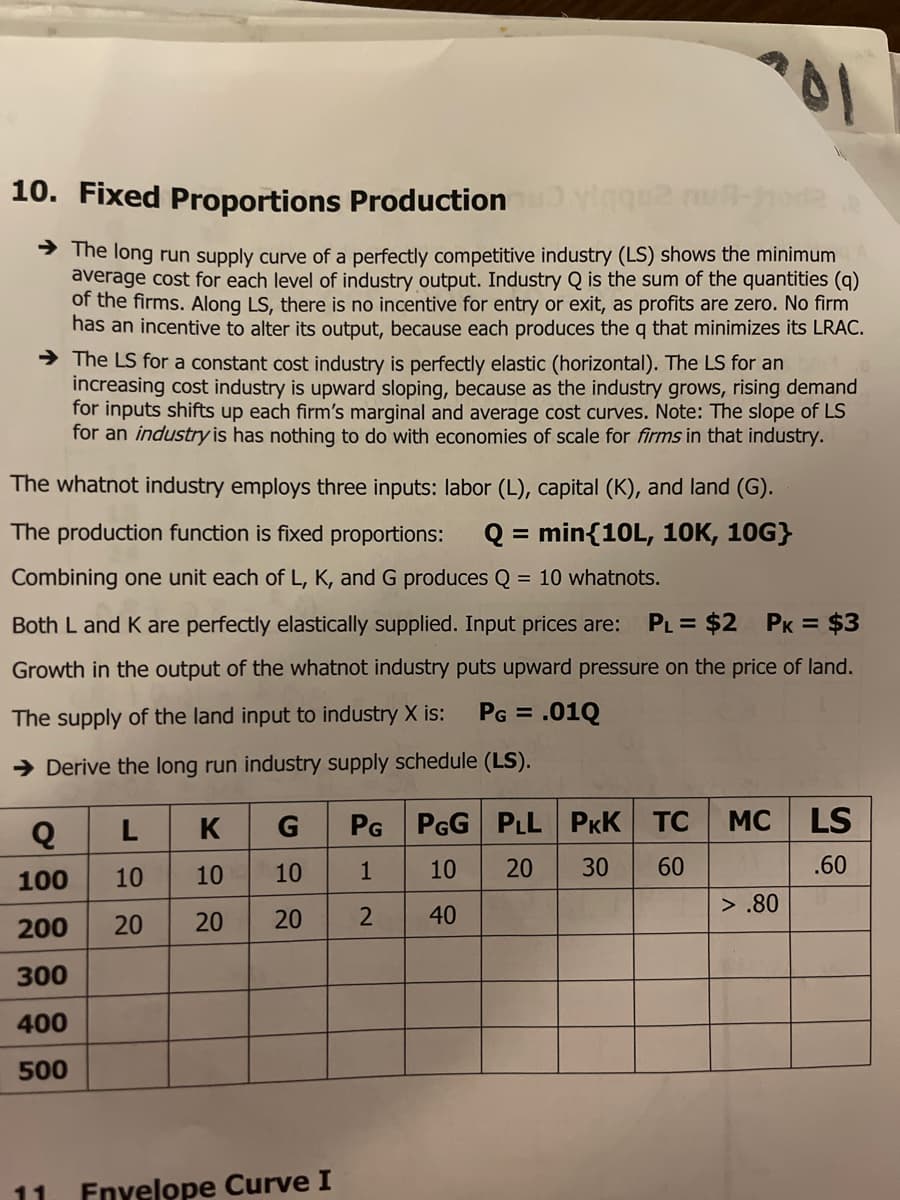10. Fixed Proportions Production vigg - The long run supply curve of a perfectly competitive industry (LS) shows the minimum average cost for each level of industry output. Industry Q is the sum of the quantities (q) of the firms. Along LS, there is no incentive for entry or exit, as profits are zero. No firm has an incentive to alter its output, because each produces the q that minimizes its LRAC. > The LS for a constant cost industry is perfectly elastic (horizontal). The LS for an increasing cost industry is upward sloping, because as the industry grows, rising demand for inputs shifts up each firm's marginal and average cost curves. Note: The slope of LS for an industry is has nothing to do with economies of scale for firms in that industry. The whatnot industry employs three inputs: labor (L), capital (K), and land (G). The production function is fixed proportions: Q = min{10L, 10K, 10G} %3D Combining one unit each of L, K, and G produces Q = 10 whatnots. %3D Both L and K are perfectly elastically supplied. Input prices are: PL = $2 PK = $3 Growth in the output of the whatnot industry puts upward pressure on the price of land. The supply of the land input to industry X is: PG = .01Q %3D → Derive the long run industry supply schedule (LS). K G PG PGG PLL PkK TC MC LS 100 10 10 10 1 10 30 60 .60 > .80 200 20 20 20 40 300 400 500 20
10. Fixed Proportions Production vigg - The long run supply curve of a perfectly competitive industry (LS) shows the minimum average cost for each level of industry output. Industry Q is the sum of the quantities (q) of the firms. Along LS, there is no incentive for entry or exit, as profits are zero. No firm has an incentive to alter its output, because each produces the q that minimizes its LRAC. > The LS for a constant cost industry is perfectly elastic (horizontal). The LS for an increasing cost industry is upward sloping, because as the industry grows, rising demand for inputs shifts up each firm's marginal and average cost curves. Note: The slope of LS for an industry is has nothing to do with economies of scale for firms in that industry. The whatnot industry employs three inputs: labor (L), capital (K), and land (G). The production function is fixed proportions: Q = min{10L, 10K, 10G} %3D Combining one unit each of L, K, and G produces Q = 10 whatnots. %3D Both L and K are perfectly elastically supplied. Input prices are: PL = $2 PK = $3 Growth in the output of the whatnot industry puts upward pressure on the price of land. The supply of the land input to industry X is: PG = .01Q %3D → Derive the long run industry supply schedule (LS). K G PG PGG PLL PkK TC MC LS 100 10 10 10 1 10 30 60 .60 > .80 200 20 20 20 40 300 400 500 20
Chapter8: Perfect Competition
Section: Chapter Questions
Problem 2.4P
Related questions
Question
Given this practice question could I get help understanding how to fill out the table?

Transcribed Image Text:10.
Fixed Proportions Production
> The long run supply curve of a perfectly competitive industry (LS) shows the minimum
average cost for each level of industry output. Industry Q is the sum of the quantities (q)
of the firms. Along LS, there is no incentive for entry or exit, as profits are zero. No firm
has an incentive to alter its output, because each produces the q that minimizes its LRAC.
> The LS for a constant cost industry is perfectly elastic (horizontal). The LS for an
increasing cost industry is upward sloping, because as the industry grows, rising demand
for inputs shifts up each firm's marginal and average cost curves. Note: The slope of LS
for an industry is has nothing to do with economies of scale for firms in that industry.
The whatnot industry employs three inputs: labor (L), capital (K), and land (G).
The production function is fixed proportions:
Q = min{10L, 10K, 10G}
Combining one unit each of L, K, and G produces Q = 10 whatnots.
Both L and K are perfectly elastically supplied. Input prices are:
PL = $2 PK = $3
Growth in the output of the whatnot industry puts upward pressure on the price of land.
The supply of the land input to industry X is:
PG = .01Q
→ Derive the long run industry supply schedule (LS).
L
K
G
PG
PGG
PLL PKK
TC
MC
LS
100
10
10
10
1
10
30
60
.60
> .80
200
20
20
20
2
40
300
400
500
11
Fnyelope Curve I
20
Expert Solution
This question has been solved!
Explore an expertly crafted, step-by-step solution for a thorough understanding of key concepts.
This is a popular solution!
Trending now
This is a popular solution!
Step by step
Solved in 2 steps with 3 images

Knowledge Booster
Learn more about
Need a deep-dive on the concept behind this application? Look no further. Learn more about this topic, economics and related others by exploring similar questions and additional content below.Recommended textbooks for you


Essentials of Economics (MindTap Course List)
Economics
ISBN:
9781337091992
Author:
N. Gregory Mankiw
Publisher:
Cengage Learning



Essentials of Economics (MindTap Course List)
Economics
ISBN:
9781337091992
Author:
N. Gregory Mankiw
Publisher:
Cengage Learning


Managerial Economics: Applications, Strategies an…
Economics
ISBN:
9781305506381
Author:
James R. McGuigan, R. Charles Moyer, Frederick H.deB. Harris
Publisher:
Cengage Learning


Principles of Microeconomics
Economics
ISBN:
9781305156050
Author:
N. Gregory Mankiw
Publisher:
Cengage Learning